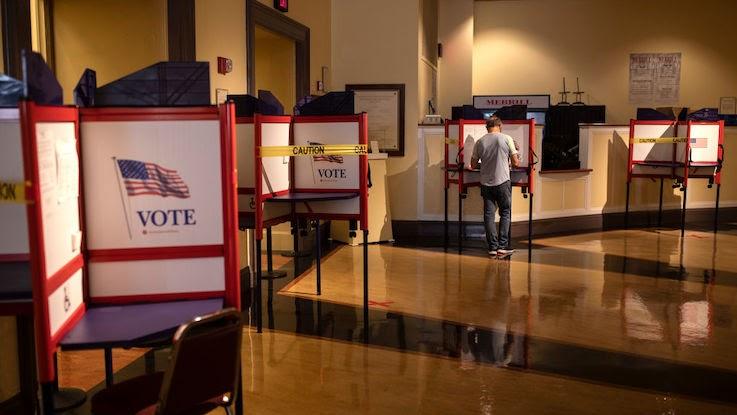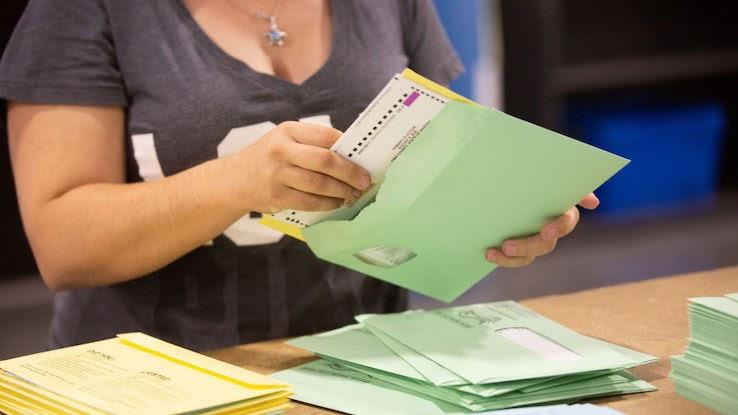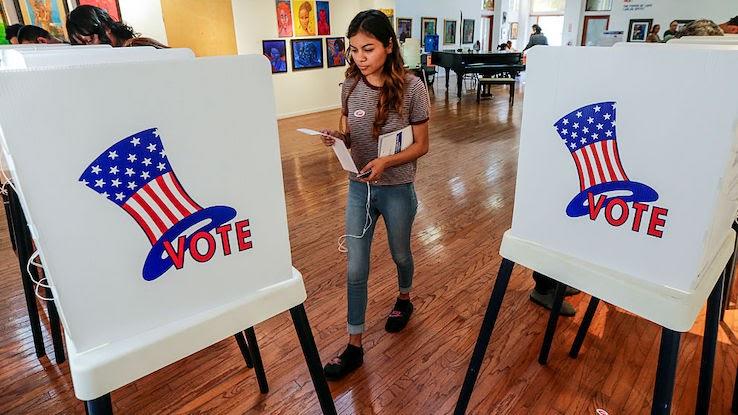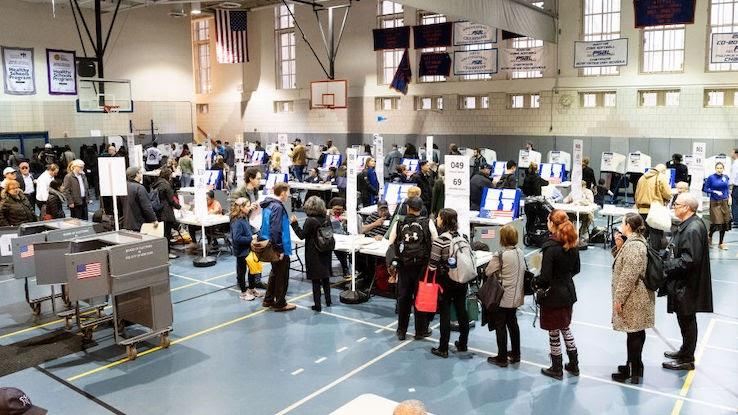Can I Register To Vote At 17 In Nyc

Want to do your part in shaping political outcomes in your city, state and country? There's almost no better way to do it than to vote. Casting your ballot in an election means you're participating in the democratic process — that you're making a difference and sending a message about the issues that concern you and the candidates you feel best represent you.
If you haven't participated in a presidential or federal election before, it's essential to make sure you're registered to vote if you want to be part of the decision-making activities that ultimately shape our lives and the state of our country. These general guidelines will help you figure out the details and steps you need to know and follow to get registered.
Are You Eligible to Vote?
Once you turn 18, you're of legal voting age in the United States. But just as different states have varying laws about everything from doing business to getting married, they also have different rules about registering to vote. In particular, states have different deadlines for the date by which you need to be registered if you want to participate in an election. The first steps in getting registered are determining your eligibility and finding out which state-specific laws and processes you need to follow in order to register.

Generally, you're eligible to vote if you're a U.S. citizen, if you meet your state's residency requirements, if you're age 18 on or before election day and if you're registered to vote based on your state's rules and registration deadlines. To find out your state's deadlines and regulations regarding voting, visit USA.gov's alphabetized list and click on your state to learn the details.
Although states used to have durational residency requirements, meaning you had to have lived in a state for a certain length of time before being eligible to vote there, most states have eliminated these mandates. You do, however, need to be a legal resident of your state, which typically means that you need to live there for more than 183 days out of every year. For the most accurate information, again check with the Secretary of State's office in the state where you plan to claim residency. If you're experiencing homelessness, are living in transitional housing or have a nontraditional address, you can still meet your state's residency requirements; you'll likely just have a physical address that's different from the mailing address you put down when you register to vote. Living overseas or serving in the military also don't affect your eligibility.
Knowing what makes you eligible to vote is important, but it's just as important to know what can make you ineligible to vote. If you're not a U.S. citizen you're not eligible to vote, even if you're a permanent legal resident. In presidential elections specifically, if you live in a U.S. territory — even if you're a U.S. citizen — you're not able to vote. Some felony convictions may also make you ineligible to vote, but this depends on your state of residence's individual laws. In some states, people who are deemed mentally incapacitated or incompetent or who have court-appointed guardians cannot vote.
Once you've determined that you're eligible to vote in your state of residence, it's time to get registered so you'll be able to cast your ballot. Every state except North Dakota requires that voters are registered before an election if they want to vote. Once you're registered to vote, you don't need to re-register unless you change your name, move to a new state, want to declare a new affiliation with a different political party or haven't voted in the last four years.

First, find your state's voter registration deadline. This can help you establish a timeline to ensure you're taking care of the necessary steps well before election day and can register on time. Some states require that you're registered as many as 30 days before an election if you want to vote in it. That's why it's essential to plan ahead and gather details about the process before you get started.
When you find out your state's deadline for registering, check to see what your voter status is if you've registered in the past and are unsure if your registration is still valid after a name change or other condition that may necessitate re-registration. This tool from the National Association of Secretaries of State can help. Select your state from the drop-down menu and then fill out and submit your personal information to see your current registration status.
Once you know you're eligible to register, have time to do so and know you aren't currently registered, it's time to get registered so you can vote. Thirty-nine states and the District of Columbia allow you to complete the registration process online. Vote.gov lets you see whether your state permits online registrations — and, if it doesn't, the site explains what you'll need to do to get registered. Assuming your state lets you sign up online, this website can help you complete the process.
When you select your state on Vote.gov, you'll be given two options if your state allows online registrations. Click the link that reads "Start your online registration on [your state's] election website" to begin the process online. You'll follow the prompts on your state's site, add your personal information and submit your application there. You can also select the link on your state's Vote.gove page that reads "Find out other ways to register to vote in [your state]" if you're not comfortable completing your registration online. If your state doesn't allow online registration, Vote.org lets you know that this option is currently unavailable and provides a link to your state's election website. Click on that to learn more. Once there, you can find out the process for registering. If you prefer to mail in your voter application for any reason, you can download a copy from the U.S. Election Assistance Commission website, print it, fill it out and send it in.
Depending on your state's laws about the process, printing out the voter application, filling it out and mailing it in to a local election office for processing may be your only available method of registering. Your state's election website should also provide details about how to register if you're living overseas or are in the military.
Which Ballot Is Right for You?
Next, it's time to find out your options for voting in your state so you're prepared to cast your ballot when the time comes. Some states primarily vote by mail, meaning you're automatically mailed a ballot a certain number of days before an election and, after filling it out, you mail it back in in the provided return envelope or put it in a local ballot drop box. If this is the procedure for your state, or if voting by mail is an option for you and you choose it, it's important to be aware of any restrictions to follow on voting day. For example, you'll likely need your ballot to be postmarked on or before election day, or you may have to place your ballot in the drop box by a certain time on election day. Use your state's election website to find important dates, times and drop box locations so you can plan ahead. Keep in mind, too, that states where voting by mail is automatic still typically have at least one polling location open per county on election day if you prefer to cast your vote in person.

All remaining states still allow you to vote by mail as an absentee voter, but the process isn't automatic like it is in a few others. You'll have to apply separately for a mail-in ballot. In some states you may need to provide justification for why you should receive an absentee voting form, and only certain excuses are permitted. For example, you might only be allowed to vote using an absentee ballot if you're a caregiver, if you'll be out of the state on election day or if your work shift prevents you from getting to a polling place during the hours that it's open. This resource from The Hill lists each state's rules about mail-in voting, which have the potential to change as the COVID-19 pandemic continues — most state laws have provisions for enacting all-mail voting in the case of certain emergencies, and your governor may decide to do so to prevent the spread of the virus. While the resource is comprehensive, it's best to visit your state's official election website for the most up-to-date information about shifting policies and procedures regarding voting.
In general, voting by mail is very convenient for many Americans, and it can save you costs in terms of time you would've spent traveling to a polling place and the money you'd spend to get there. You don't have to take time off work, find childcare or stand in a long line to vote, either. However, absentee voting does have a few downsides that you'll want to consider before you decide whether to ask for this type of ballot or not. If you feel as though a family member or someone else in your household may try to coerce you into changing your vote, visiting a polling place may feel like a safer experience for you because of the extra privacy. If you live on a reservation, the post office may also have difficulty delivering your ballot if you share a P.O. box with other people or don't have a traditional street address.
Visiting a polling place to vote also has its associated advantages and downsides. Traditionally, voting involves going to a local polling place, waiting in line and filling out and submitting either a paper ballot or a digital ballot on an electronic voting machine. For many people, this is one of the upsides. You're getting out into your community and participating in civic engagement; this can energize you, help you forge bonds with neighbors and give you the full voting experience — which can be especially valuable if this is your first time voting. There's also the issue of security: What if your absentee ballot gets lost in the mail or something invalidates it and you're unaware that your vote ended up not getting counted? This is less likely to happen if you vote in person, as is coercion because you'll be in the voting booth alone. If you live in a rural area and don't have easy access to a polling place or transportation, however, you may find it too difficult and time-consuming to physically get out and vote. Additionally, you may have a disability that makes it difficult to stand in line for long periods of time, which you might need to do at a polling place.
Ultimately, the type of ballot and voting process you choose is just that — your choice. Take your lifestyle, employment status, abilities and preferences into account to decide which method you're most comfortable with.
When Do Elections Take Place?
While the presidential and other federal elections happen on the same date for everyone around the country, various state-level elections take place throughout the year where you live. Federal elections include voting for the president and vice president, the House of Representatives and some of the Senate. State and local races may appear on your ballot at this time, too. But at other times of the year, you may need to vote in special state and county elections or primaries, the dates of which depend on your location.

Knowing when these elections take place further helps you prepare and plan to participate, but where do you find out when they happen? Again, your state's election website will have the most current, accurate information about various relevant dates, including election days, registration deadlines for participating in each election, the dates ballots are mailed out and other important deadlines to be aware of.
Participating in Elections: How Should You Get Ready?
Once you're aware of the process and have chosen how you'll vote, the next step is to determine where you'll do it. Voting by mail is as easy as placing the ballot in the return envelope and setting it in your mailbox or sliding it into a local drop box, but if you plan to visit an actual polling place, it's important to know where you need to go well before election day rolls around. This way, you can plan ahead and won't be stressed at the last minute while trying to figure out the location or secure transportation there.

Traditionally, in-person voting often took place in buildings that served other purposes. Churches, schools and community centers have often done double duty as polling places. People voted based on their precincts, which are the smallest geographical units that voting districts are divided up into. Fortunately, figuring out where you'll go to cast your vote doesn't involve determining your precinct these days, and your county may have a designated voting center where you'll vote instead of a school. The U.S. Vote Foundation offers a directory where you can choose your state and county to see a list of in-person voting locations, and Vote.org also has a helpful polling place locator that uses some of your personal information to determine where you should go to vote or forwards you to your Secretary of State's website to learn more.
Voting can take some careful planning and preparation, but participating in free and fair elections is a fundamental part of engaging in the democratic process. It's one of the most meaningful ways to exercise your rights as a U.S. citizen and work to create the society you want to see. Take some time to get registered today to make a difference in your community and your country and help shape history in the process.
MORE FROM REFERENCE.COM
Can I Register To Vote At 17 In Nyc
Source: https://www.reference.com/world-view/how-to-register-to-vote?utm_content=params%3Ao%3D740005%26ad%3DdirN%26qo%3DserpIndex
Posted by: gamblindrined.blogspot.com

0 Response to "Can I Register To Vote At 17 In Nyc"
Post a Comment